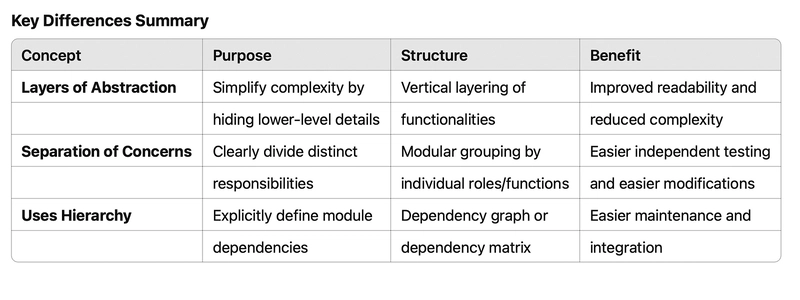Stop Confusing Layers of Abstraction with Separation of Concerns
 Maneesh Chaturvedi
Maneesh Chaturvedi
Developers often treat “abstraction layers” and “separation of concerns” as interchangeable terms. But in software design, they represent fundamentally different concepts — each with its own design goal, trade-offs, and failure modes.
This post breaks down the differences, explains common mistakes, and introduces uses hierarchy *— an often overlooked perspective that can make or break modular system design.
📚 Layers of Abstraction
Layers of abstraction involve organizing software into distinct layers, with each layer abstracting or hiding complexities from the layers above it. Crucially, each layer deals with the same underlying concept, simplifying interactions progressively as we move upward.
Example: File System
User Interface Layer: Simple operations (e.g., open, save) without hardware details.
Logical File System Layer: Manages files, metadata, permissions.
Physical File System Layer: Manages disk storage and hardware operations.
Each layer addresses the same core concept (files) but at different abstraction levels, progressively simplifying user interaction.
🧩 Separation of Concerns
Separation of concerns is the principle of organizing a system so each component addresses distinct, independent functionalities. Unlike abstraction layers, these components aren't simplifying the same concept but managing entirely different responsibilities.
Example: MVC Architecture
Model: Handles business logic and data.
View: Manages user interface presentation.
Controller: Processes user inputs and updates Model/View accordingly.
Each component has clearly separate responsibilities, enabling independent development, testing, and maintenance.
🎯 Clarifying Common Confusion
Many developers confuse layers of abstraction with separation of concerns. However, the critical difference is:
Layers of Abstraction: Vertically abstract complexity for the same underlying concept. Each layer simplifies the view of the same functionality.
Separation of Concerns: Horizontally separate distinct functionalities into independent modules or components. Each part handles completely different responsibilities.
For instance, layers of abstraction simplify operations on the same concept (like file management), while separation of concerns clearly divides unrelated functionalities (like UI, business logic, and data handling).
⚙️ Uses Hierarchy (by David Parnas)
David Parnas defined "uses hierarchy" through explicit module dependencies, represented using a binary dependency matrix:
Entry (A, B) is true if module A's correctness depends directly on module B.
The uses hierarchy clearly identifies modules and dependencies, enabling easier maintenance and modular testing.
📌 Example of Uses Hierarchy:
Consider a simplified text editor:
In this dependency structure:
The User Interface uses the Command Interpreter.
The Command Interpreter uses Text Manipulation.
Text Manipulation relies on the Database module.
If we remove the Database module, we must also remove Text Manipulation (as it directly depends on Database), Command Interpreter (which depends on Text Manipulation), and subsequently, the User Interface (which depends on Command Interpreter). Thus, removing one module can cascade through dependent modules, clearly illustrating why careful management of dependencies is essential.
📌 Key Differences Summary
🚀 Practical Importance
Clearly defined layers of abstraction help reduce complexity and improve readability.
Separation of concerns allows independent modification and easier testing.
A well-defined uses hierarchy makes it simpler to maintain modules, manage dependencies, and incrementally develop systems.
🔑 Conclusion
Understanding these three key concepts - layers of abstraction, separation of concerns, and uses hierarchy - can greatly enhance software design, making systems more maintainable, scalable, and robust. Embracing these principles will empower you as a developer to manage complexity more effectively and write software that's easier to maintain and extend.
If this helped clarify a few design principles you’ve always found fuzzy, follow me here for more deep dives into the craft of software design and modular thinking. Let’s make better software — one abstraction at a time.
Subscribe to my newsletter
Read articles from Maneesh Chaturvedi directly inside your inbox. Subscribe to the newsletter, and don't miss out.
Written by


